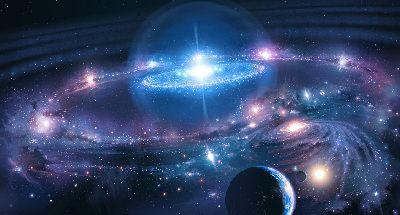
It's hard to describe billions of years of cosmic(of the universe)history. But scientists have used a code to create a model of how the universe as we know it today might have evolved.
A new study in the journal Nature describes a simulation (模拟)of the universe that is unique because of "how realistically it recreates the galaxies(星群) and the universe that we see, which is kind of a first for a simulation like this," said Dylan Nelson, study co-author at the Harvard-Smithsonian Center for Astrophysics.
Running this model "took about 16 million CPU hours," Michael Boylan-Kolchin, astronomer at the University of Maryland, College Park, wrote in an accompanying article in Nature. "The end result, however, is a simulated universe that looks an awfully lot like the real one."
This simulation begins 12 million years after the Big Bang, which is still pretty early considering that the universe is about 13.8 billion years old.
"What it allows— a statistically robust comparison against observations across all of cosmic time—is a critical aspect in the development of better and more realistic models, which directly translates into more physical insight which we can extract from such simulations," Nelson said.
A total of 41,416 galaxies are represented in the simulation. It includes a population of elliptical galaxies that don't form stars, disk galaxies that do form stars, and irregular galaxies.
Our own Milky Way galaxy is a disk galaxy, and simulating how such a galaxy would be formed has been problematic in the past. But the scientists' calculations have overcome this, the study said.
The simulation takes into account that there are phenomena in our universe that we have never detected but that have had huge influence on cosmic evolution. Dark matter accounts for about 24% of the universe, while normal matter—everything that we can see— is only 4.6%.
Dark matter "dominates the gravitational pull of everything, especially on large scales," Nelson said. "It's the backbone of the cosmic web."
Over the course of the universe's history, galaxies have formed where dark matter was most concentrated. But most of the universe is made of dark energy, responsible for the accelerating expansion of the universe.
本时文内容由奇速英语国际教育研究院原创编写,禁止复制和任何商业用途,版权所有,侵权必究!
1.What’s the purpose of the study?
A To praise scientists’ hard work.
B To prove a new method.
C To show the evolution of the universe.
D To find out a new star.
解析:选C。C 细节理解题。根据第1段第2句scientists have used a code to create a model of how the universe as we know it today might have evolved可知答案,故选C。
2.What helps the scientists carry out the study?
A The University of Maryland.
B A simulation of the universe.
C An accompanying article.
D A disk galaxy.
解析:选B。B 细节理解题。根据第2段第1句中...a simulation of the universe that is unique because of "how realistically it recreates the galaxies可知答案,故选B。
3.The number of galaxies included in the simulation is _______.
A about 16 million
B over 40 thousand
C nearly 13.8 billion
D just 4.6 thousand
解析:选B。B 细节理解题。由第6段第1句A total of 41,416 galaxies are represented in the simulation. 可知答案,故选B。
4.The underlined word "detected" probably means ______.
A met
B touched
C felt
D noticed
解析:选D。D 词义推测题。根据句意,在宇宙中有一些我们从来没发现过的现象,但却对宇宙的进化有着巨大的影响,故选D。
5.What can we infer from the last paragraph?
A The universe has stopped its expansion.
B The universe is made of dark energy.
C The universe is ever developing.
D The universe is made of dark matter.
解析:选C。C 推理判断题。由... responsible for the accelerating expansion of the universe可知宇宙一直在扩张发展,故选C。